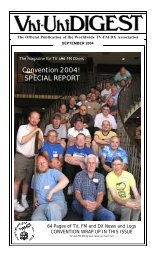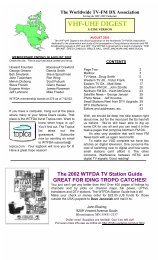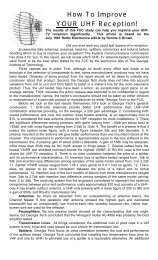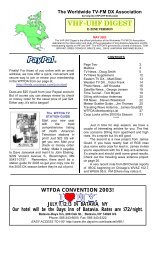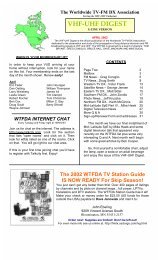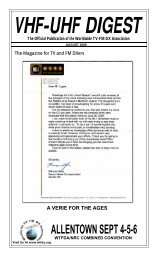A Review of the Grundig G8 and Tecsun PL-300WT - Wtfda.org
A Review of the Grundig G8 and Tecsun PL-300WT - Wtfda.org
A Review of the Grundig G8 and Tecsun PL-300WT - Wtfda.org
Create successful ePaper yourself
Turn your PDF publications into a flip-book with our unique Google optimized e-Paper software.
A <strong>Review</strong> <strong>of</strong> <strong>the</strong><br />
<strong>Grundig</strong> <strong>G8</strong> <strong>and</strong> <strong>Tecsun</strong> <strong>PL</strong>-<strong>300WT</strong><br />
The <strong>Grundig</strong> <strong>G8</strong> <strong>and</strong> <strong>Tecsun</strong> <strong>PL</strong>-<strong>300WT</strong> are among<br />
<strong>the</strong> latest Ultralight Radio (ULR) <strong>of</strong>ferings to become<br />
available. Both are manufactured by <strong>Tecsun</strong> in<br />
China, <strong>and</strong> functionally <strong>the</strong>y are <strong>the</strong> exact same<br />
receiver, with <strong>the</strong> only difference being <strong>Grundig</strong>’s<br />
popular black rubberized finish on <strong>the</strong> <strong>G8</strong>, while <strong>the</strong><br />
<strong>PL</strong>-<strong>300WT</strong> comes in black <strong>and</strong> silver with a smooth<br />
plastic finish. <strong>Grundig</strong> promotional literature is<br />
surprisingly inaccurate, making it appear that <strong>the</strong> <strong>G8</strong><br />
<strong>and</strong> <strong>PL</strong>-<strong>300WT</strong> are quite different in size <strong>and</strong><br />
features; however, <strong>the</strong>se are in fact <strong>the</strong> same radio,<br />
<strong>and</strong> I will generally refer only to <strong>the</strong> <strong>G8</strong> in this article.<br />
The <strong>G8</strong> is now widely available in North America<br />
<strong>and</strong> elsewhere through eBay, Amazon, Universal<br />
Radio, C Crane, Radio Shack, <strong>and</strong> many o<strong>the</strong>r<br />
outlets. The list price for both is $50, <strong>and</strong> may<br />
include free shipping. As discussed below, <strong>the</strong> quality control (QC) on <strong>the</strong> <strong>Grundig</strong> <strong>G8</strong> is noticeably better based<br />
on units received to date, it comes with a warranty, <strong>and</strong> can be returned to a domestic distributor, making <strong>the</strong> <strong>G8</strong><br />
<strong>the</strong> presumed choice for many DXers. However, <strong>the</strong> performance <strong>of</strong> both radios is identical. The owner’s<br />
manual supplied with both sets is quite brief <strong>and</strong> only marginally useful. The exception is <strong>the</strong> manual supplied by<br />
some distributors <strong>of</strong> <strong>the</strong> <strong>PL</strong>-<strong>300WT</strong>, which has been scanned <strong>and</strong> posted to <strong>the</strong> Yahoo UltralightDX group.<br />
Current <strong>and</strong> prospective owners <strong>of</strong> ei<strong>the</strong>r model should download this version <strong>of</strong> <strong>the</strong> manual.<br />
Features <strong>of</strong> <strong>the</strong> <strong>G8</strong><br />
The <strong>G8</strong> covers <strong>the</strong> following frequency ranges:<br />
LW: 153 to 513 KHz<br />
MW: 520 to 1710 KHz<br />
SW: 3.15 to 21.95 MHz<br />
FM: 64/76/87 to 108 MHz<br />
The shortwave spectrum is broken into several b<strong>and</strong>s<br />
for tuning ease, <strong>and</strong> it remembers where you were in<br />
each b<strong>and</strong>; however, <strong>the</strong> entire range in available<br />
using <strong>the</strong> tuning thumbwheel. There are 200<br />
memories for shortwave, <strong>and</strong> 100 each for FM, AM<br />
<strong>and</strong> LW. There are no jacks for connecting external<br />
antennas (more on that below), <strong>and</strong> <strong>the</strong> internal<br />
antennas include a 22” whip antenna for FM <strong>and</strong> SW<br />
<strong>and</strong> a 3.5 inch ferrite for AM <strong>and</strong> LW. There is no<br />
SSB capability or RF gain control.<br />
The radio measures 135 x 86 x 26 mm. (about 5.3 x 3.4 x 1 inches), which just barely fits into my shirt pocket,<br />
<strong>and</strong> so likely represents <strong>the</strong> largest that a radio could be <strong>and</strong> still be an Ultralight. It weighs 204 grams (about 7<br />
ounces), which is typical for an ULR. It comes with a nice zippered travel case.<br />
Powering <strong>the</strong> <strong>G8</strong> requires three AA batteries or a 6-volt AC adapter (not supplied with <strong>the</strong> radio). There is no<br />
facility for recharging batteries. Battery consumption appears to be very good, in that a batch <strong>of</strong> alkaline<br />
batteries lasts at least as long <strong>the</strong> <strong>G8</strong> as in most o<strong>the</strong>r ULR models; no doubt having three batteries plays a<br />
factor here. There is a non-removable capacitor inside, which looks a lot like a large watch battery, to provide<br />
back-up power for <strong>the</strong> clock <strong>and</strong> memory functions.<br />
1
The LCD screen displays frequency, b<strong>and</strong>, time, alarm, signal strength <strong>and</strong> o<strong>the</strong>r pertinent information, <strong>and</strong> I find<br />
it quite easy to read. There is even a <strong>the</strong>rmometer which can be selected. A central feature <strong>of</strong> <strong>the</strong> design is <strong>the</strong><br />
large rotary time zone selector, which is convenient for travelers <strong>and</strong> international DXers who want to know what<br />
time it is in a given location. The alarm is fairly loud, <strong>and</strong> I used it recently while traveling <strong>and</strong> liked how it<br />
worked. There is also a sleep function which turns <strong>the</strong> radio <strong>of</strong>f after anywhere between 1 <strong>and</strong> 120 minutes (it<br />
can also be set to just stay on).<br />
Each push <strong>of</strong> a button will turn <strong>the</strong> backlight on <strong>and</strong> produce a very loud beep. The beep can be disabled (<strong>and</strong><br />
most choose to do so). The backlight can also be turned on indefinitely, although by default it goes dark about<br />
five seconds after <strong>the</strong> most recent button push in order to prolong battery life. In general, tuning <strong>and</strong> set-up<br />
comm<strong>and</strong>s are entered using <strong>the</strong> various buttons by ei<strong>the</strong>r a short or prolonged push <strong>of</strong> a given button, <strong>and</strong> I<br />
found this scheme quite straightforward to use.<br />
The single speaker has fairly robust audio, but don’t expect to fill an<br />
entire room with sound. The volume control is a rotary knob with 30<br />
détente stops. Audio is very good using headphones, although <strong>the</strong><br />
supplied ear “buds” are marginal at best. There is a fair amount <strong>of</strong> hiss<br />
when using headphones at low volume levels.<br />
A quick <strong>and</strong> simple fix for this is to get a headphone volume control<br />
(Radio Shack 210-2975 or similar, at right) to provide attenuation. This<br />
will allow you to turn up <strong>the</strong> volume on <strong>the</strong> radio while still maintaining<br />
low volume in your headphones. This volume control is also h<strong>and</strong>y for<br />
connecting <strong>the</strong> <strong>G8</strong> to <strong>the</strong> MIC-level input <strong>of</strong> a digital recorder.<br />
DSP - Revolutionizing Ultralight Radios<br />
The heart <strong>of</strong> <strong>the</strong> <strong>G8</strong> is <strong>the</strong> Silicon Laboratories (SILABS) Si4734 chip which uses advanced digital signal<br />
processing (DSP) technology for all receiver functions. While Sony currently manufactures ULR receivers such<br />
as <strong>the</strong> SRF-59 using <strong>the</strong> CXA1129N chip as <strong>the</strong> actual receiver part <strong>of</strong> <strong>the</strong> radio, <strong>the</strong> SILABS family <strong>of</strong> DSP radio<br />
chips is truly a breakthrough in performance <strong>and</strong> low power consumption. The first manufacturers to use <strong>the</strong><br />
SILABS chips in consumer-grade radios are <strong>Tecsun</strong> <strong>and</strong> Kchibo, <strong>and</strong> I look forward to more manufacturers using<br />
this technology.<br />
AM Performance<br />
As can be seen in <strong>the</strong> functional block<br />
diagram at left, a manufacturer only needs to<br />
provide a power supply, an antenna input, a<br />
display <strong>and</strong> a final audio section for sound,<br />
while <strong>the</strong> DSP chip takes care <strong>of</strong> all o<strong>the</strong>r<br />
receiver-related functions.<br />
A demonstration board is available from<br />
Mouser Electronics (part number 634-<br />
SI4731-DEMO), which allows you to vary any<br />
<strong>of</strong> <strong>the</strong> parameters (b<strong>and</strong>width, etc.).<br />
The <strong>G8</strong> represents a major step forward in ULR performance. It is very sensitive, <strong>and</strong> once properly aligned, <strong>the</strong><br />
sensitivity is as good as any ULR, equaling that <strong>of</strong> <strong>the</strong> Eton e100 <strong>and</strong> Sangean DT-400W, <strong>the</strong> reigning sensitivity<br />
champions. Since <strong>the</strong> <strong>G8</strong> has a single optimum antenna coil on <strong>the</strong> ferrite, sensitivity is consistent throughout<br />
<strong>the</strong> b<strong>and</strong>.<br />
2
Of particular interest to DXers is <strong>the</strong> fact that <strong>the</strong> <strong>G8</strong>'s selectivity is <strong>the</strong> best ever measured in a stock ULR,<br />
thanks to DSP technology. The low IF architecture, as with <strong>the</strong> Sony CXA-1129 chip, allows for on-chip IF<br />
filtering that would not be remotely possible using a typical 455 KHz IF frequency. The Si4734 chip has five AM<br />
b<strong>and</strong>widths available (1, 2, 3, 4 <strong>and</strong> 6 KHz per sideb<strong>and</strong>), <strong>and</strong> comparisons with <strong>the</strong> demonstration board show<br />
that <strong>Tecsun</strong> chose <strong>the</strong> 3 KHz setting for <strong>the</strong> <strong>G8</strong>.<br />
Based on some brief testing, which involved simply tuning in 1 KHz increments away from strong local stations in<br />
my area <strong>and</strong> noting <strong>the</strong> displayed signal strength levels, I was able to confirm that <strong>the</strong> <strong>G8</strong>’s sensitivity is in fact<br />
down approximately 6 decibels at <strong>the</strong> 3 KHz point. The full results are plotted below <strong>and</strong> compared with o<strong>the</strong>r<br />
filtering schemes. I was able to tune up to 5 KHz away on <strong>the</strong> <strong>G8</strong> before <strong>the</strong> signal levels were obviously<br />
suspect, so <strong>the</strong> latter portion <strong>of</strong> <strong>the</strong> <strong>G8</strong>’s selectivity graph is an estimate.<br />
AM Selectivity Comparison<br />
The graph above shows that <strong>the</strong> <strong>G8</strong>’s selectivity is quite similar to that produced by <strong>the</strong> Murata CFR-455I<br />
ceramic filter, with <strong>the</strong> Murata having a better shape factor <strong>and</strong> skirt selectivity. The chart also makes clear that<br />
<strong>the</strong> <strong>G8</strong> is significantly more selective than <strong>the</strong> previous ULR selectivity champion, <strong>the</strong> Eton e100, even with two<br />
<strong>of</strong> <strong>the</strong> Eton e100’s stock P-55I filters cascaded toge<strong>the</strong>r. Also included for comparison are <strong>the</strong> LTM-455HT (a<br />
good mass-market filter), both individually <strong>and</strong> cascaded, <strong>and</strong> two o<strong>the</strong>r high-quality Murata ceramic filters.<br />
3<br />
As a result, for domestic DXing with 9 or 10 KHz<br />
frequency separation, <strong>the</strong> <strong>G8</strong> is clearly <strong>the</strong> best<br />
Ultralight available. However, as seen in <strong>the</strong><br />
chart above <strong>and</strong> proven by DXers in <strong>the</strong> field,<br />
<strong>the</strong> Murata CFJ455K5 filter, when transplanted<br />
into an Eton e100 or C Crane SWP (left), is still<br />
<strong>the</strong> champion by a comfortable margin in terms<br />
<strong>of</strong> separating trans-oceanic stations spaced only<br />
a few KHz from domestic stations.<br />
The new Kchibo D92L <strong>and</strong> K96L receivers are<br />
able to select all five <strong>of</strong> <strong>the</strong> DSP filter<br />
b<strong>and</strong>widths available on <strong>the</strong> Si4734 chip, <strong>and</strong><br />
<strong>the</strong>refore may be more competitive with Murataequipped<br />
receivers.
For tuning, <strong>the</strong> innovative FAST/SLOW thumbwheel is very user-friendly, <strong>and</strong> I rarely regret not having a keypad<br />
for direct frequency entry. In SLOW, tuning goes in 1 or 9/10 KHz steps, depending on how fast you spin <strong>the</strong><br />
tuning thumbwheel. In FAST mode, <strong>the</strong> <strong>G8</strong> tunes in 9/10 <strong>and</strong> 100 KHz steps. I recommend that new users start<br />
in SLOW mode until <strong>the</strong>y become accustomed to <strong>the</strong> way <strong>the</strong> radio automatically adjusts <strong>the</strong> tuning rate in<br />
dependence upon <strong>the</strong> speed with which <strong>the</strong> tuning thumbwheel is turned.<br />
By using <strong>the</strong> SLOW tuning setting, you can detune 2-3 KHz in ei<strong>the</strong>r direction to avoid interference <strong>and</strong> brighten<br />
<strong>the</strong> audio. If you use a passive loop to augment <strong>the</strong> signal, you can tune 4 KHz away <strong>and</strong> still allow enough <strong>of</strong><br />
<strong>the</strong> carrier frequency in to produce a listenable signal. I have noticed that tuning in 1 KHz increments<br />
near/through strong locals may produce an audible “whoop” sound which promptly goes away <strong>and</strong> doesn’t affect<br />
reception, indicating that <strong>the</strong> sound is likely produced by <strong>the</strong> automatic gain control (AGC) circuit. Detuning even<br />
1 KHz significantly lowers volume, <strong>and</strong> <strong>the</strong> SNR reading will drop to zero even though signal strength is still<br />
ample signal. As a side note, <strong>the</strong> signal strength <strong>and</strong> SNR indicators appear to be relative values, <strong>and</strong> are not<br />
reliable for field strength measurements. Also, <strong>the</strong> sampling rate <strong>of</strong> <strong>the</strong> signal level is quite slow (updates every<br />
two seconds or so), so using it as a measure during passive loop usage, phasing or alignments can be difficult.<br />
One issue that many users have noticed is that volume changes can be excessive when a weak station fades<br />
up. The Si4734 chip has a s<strong>of</strong>t-muting feature which decreases audio level when signal strengths are low, <strong>and</strong><br />
restores <strong>the</strong> volume once a threshold signal strength level is reached (<strong>the</strong> default level is 25 dB). Based on <strong>the</strong><br />
abrupt volume change, this apparently indicates that <strong>the</strong> s<strong>of</strong>t muting algorithm could be better. Some have<br />
speculated that <strong>the</strong> AGC circuit is to blame, although <strong>the</strong> AGC would actually decrease volume when a station<br />
fades up, <strong>and</strong> <strong>the</strong>refore is probably not <strong>the</strong> culprit here. In any event, a passive loop which keeps <strong>the</strong> signal<br />
level up will likely cure this issue.<br />
One design flaw that many DXers have noticed is <strong>the</strong> present <strong>of</strong> several heterodynes/birdies towards <strong>the</strong> top <strong>of</strong><br />
<strong>the</strong> MW b<strong>and</strong>. The cause <strong>of</strong> <strong>the</strong>se is not yet clear. They appear to act like heterodynes, in that tuning<br />
approximately 2 KHz above <strong>the</strong> base frequency (i.e., tuning to 1612 from 1610) will reduce <strong>the</strong> tone to nearly a<br />
zero-beat. The IF for <strong>the</strong> AM section is based on a 32.768KHz oscillator, which may be <strong>the</strong> source.<br />
Investigations into <strong>the</strong> G6 model reveal poor shielding <strong>of</strong> <strong>the</strong> display circuits that run on a different internal<br />
frequency, which may also be part <strong>of</strong> <strong>the</strong> cause. In any event, <strong>the</strong> use <strong>of</strong> a passive external antenna usually<br />
removes <strong>the</strong> heterodyne/birdie, indicating that sufficient RF signal is able to drown <strong>the</strong> tone out. I have also<br />
noticed tones on low-b<strong>and</strong> frequencies (540-700 KHz) that do NOT behave like heterodynes, in that detuning<br />
does not change <strong>the</strong>ir pitch; however, <strong>the</strong>y are also removed through <strong>the</strong> use <strong>of</strong> an external passive antenna.<br />
More research is needed here to determine <strong>the</strong> actual cause(s).<br />
Ano<strong>the</strong>r interesting anomaly is that <strong>the</strong> volume level increases when ei<strong>the</strong>r <strong>of</strong> <strong>the</strong> two buttons below <strong>the</strong> power<br />
button are depressed, which indicates that <strong>the</strong> AGC circuit is temporarily disabled or bypassed. Supporting this<br />
conclusion is <strong>the</strong> fact that <strong>the</strong> heterodynes/birdies mentioned just above will <strong>of</strong>ten disappear, indicating that <strong>the</strong><br />
radio is temporarily receiving a much stronger signal.<br />
Once <strong>the</strong> buttons are released, <strong>the</strong> volume returns back to<br />
normal, <strong>the</strong>refore this is not a significant issue for DXers.<br />
Like <strong>the</strong> Eton e100, <strong>the</strong> <strong>G8</strong> does not seem to respond well<br />
to some passive loops such as <strong>the</strong> Quantum Stick <strong>and</strong><br />
o<strong>the</strong>r smaller units, so you may want to have at least a<br />
Terk Loop, or perhaps a Crate Loop (right) or similar for<br />
good results. The C Crane Twin Coil <strong>and</strong> its small ferrite<br />
coupler also works well with <strong>the</strong> <strong>G8</strong>.<br />
With <strong>the</strong> stock internal ferrite antenna, nulls are fairly<br />
good, although not on a par with <strong>the</strong> Kaito WRX-911, <strong>the</strong><br />
best ULR in this performance category. The <strong>G8</strong>, unlike<br />
<strong>the</strong> Eton e100, is very immune to overloads, even with<br />
large outboard ferrite antennas, making it an excellent<br />
c<strong>and</strong>idate for retr<strong>of</strong>itting a large ferrite antenna (see<br />
modifications, below), which results in much better nulls.<br />
4
The lone alignment issue associated with <strong>the</strong> <strong>G8</strong> is <strong>the</strong> ferrite antenna. In this regard, <strong>the</strong> quality control record<br />
<strong>of</strong> <strong>the</strong> <strong>G8</strong> has been noticeably better than that <strong>of</strong> <strong>the</strong> <strong>PL</strong>-<strong>300WT</strong> based on <strong>the</strong> many DXers who have reported<br />
<strong>the</strong>ir findings on as-received units, although my <strong>PL</strong>-<strong>300WT</strong> appears to be nearly optimally aligned. An<br />
outst<strong>and</strong>ing feature <strong>of</strong> <strong>the</strong> DSP chip is that <strong>the</strong>re is a single antenna coil inductance that is <strong>the</strong> “sweet spot” for<br />
<strong>the</strong> entire MW b<strong>and</strong>, <strong>the</strong>refore an alignment will <strong>of</strong>ten improve performance considerably (discussed below).<br />
Shortwave Performance<br />
Shortwave sensitivity is quite high, perhaps to a fault, since strong local MW stations will produce manifold<br />
images on <strong>the</strong> SW b<strong>and</strong>s <strong>and</strong> usually cause significant desensitization. Touching <strong>and</strong>/or retracting <strong>the</strong> whip<br />
antenna sometimes cures this problem, but at <strong>the</strong> cost <strong>of</strong> signal strength. There have been different accounts as<br />
to how bad this phenomenon is, so <strong>the</strong>re may be differences associated with listener location, individual product<br />
quality control, <strong>and</strong> perhaps o<strong>the</strong>r factors. In Europe, where <strong>the</strong>re are not many MW stations left, this issue was<br />
not observed, <strong>and</strong> SW reception was excellent. When used with an external antenna <strong>and</strong> pre-selector such as<br />
<strong>the</strong> Palstar AA-30, MFJ-1020C, Ameco TPA or similar, AND with both <strong>of</strong> <strong>the</strong> antenna leads connected to <strong>the</strong> <strong>G8</strong><br />
(one to <strong>the</strong> whip <strong>and</strong> one to a ground <strong>of</strong>f <strong>of</strong> <strong>the</strong> battery spring), shortwave performance is quite good.<br />
Selectivity is well chosen for separating stations spaced 5 KHz apart. With <strong>the</strong> good filter shape <strong>and</strong> apparently<br />
slow AGC on <strong>the</strong> <strong>G8</strong>, detuning by 2 or 3 KHz <strong>of</strong>ten results in <strong>the</strong> elimination <strong>of</strong> selective fading, since one <strong>of</strong> <strong>the</strong><br />
sideb<strong>and</strong>s is largely removed; this alternative to synchronous detection, championed by Dr. Phil B., is an underutilized<br />
tool that a DXer can take advantage <strong>of</strong>.<br />
Longwave Performance<br />
The stock <strong>G8</strong> is not a good longwave radio, since <strong>the</strong> ferrite antenna is optimized for MW frequencies. This<br />
results in abysmal sensitivity, as evidenced while DXing in Europe where longwave broadcast stations with<br />
hundreds <strong>of</strong> thous<strong>and</strong>s <strong>of</strong> watts were received with only adequate signal level. Modification <strong>of</strong> <strong>the</strong> ferrite<br />
(discussed below) can enable <strong>the</strong> <strong>G8</strong> to be a capable longwave receiver. However, without SSB capability, <strong>the</strong><br />
<strong>G8</strong> is not suitable for serious non-directional beacon (NDB) DXing.<br />
FM Performance<br />
The <strong>G8</strong> is a true FM DX machine. It has incredible sensitivity just with <strong>the</strong> 22-inch whip antenna, <strong>the</strong> best <strong>of</strong> any<br />
portable receiver regardless <strong>of</strong> size or price. Additionally, <strong>the</strong> DSP selectivity, with just <strong>the</strong> single b<strong>and</strong>width<br />
available, is likewise <strong>the</strong> best <strong>of</strong> any portable known to man. For example, when DXing in Europe where stations<br />
are spaced only 0.2 MHz apart in many cases, I was able to easily separate strong local stations from weaker<br />
distant stations at all points on <strong>the</strong> dial.<br />
The whip antenna swivels in all three axes, which is great for pin-pointing a null. The whip may become loose<br />
through prolonged use, but <strong>the</strong> Phillips-head set screw is easily re-tightened. As noted above, <strong>the</strong> whip antenna<br />
on <strong>the</strong> <strong>G8</strong> is 22 inches long, well short <strong>of</strong> <strong>the</strong> quarter-wavelength (approximately 30 inches) associated with <strong>the</strong><br />
middle <strong>of</strong> <strong>the</strong> FM b<strong>and</strong>. Attaching an extra 8 inches <strong>of</strong> wire with an alligator clip, effectively bringing it to 30<br />
inches in length, results in a noticeable improvement in signal strength <strong>and</strong> SNR for many stations, at least in my<br />
townhouse location. Therefore, transplanting a full 30-inch whip antenna onto <strong>the</strong> <strong>G8</strong> may be a good<br />
modification for those who are so inclined. Since <strong>the</strong> quarter-wavelength corresponding <strong>the</strong> 88-108 MHz FM<br />
b<strong>and</strong> is 27.3 to 33.5 inches, one might consider installing a 33.5-inch whip which could be partially retracted for<br />
DXing <strong>the</strong> upper part <strong>of</strong> <strong>the</strong> b<strong>and</strong>.<br />
Ano<strong>the</strong>r way to increase gain is to turn <strong>the</strong> <strong>G8</strong> into a half-wave dipole, aka “rabbit ears”. To do this, which in my<br />
experience adds a fur<strong>the</strong>r 2-3 dB <strong>of</strong> gain, simply connect 30 inches or so <strong>of</strong> wire (whatever <strong>the</strong> length <strong>of</strong> your<br />
whip antenna is) to <strong>the</strong> battery ground <strong>and</strong> extending <strong>the</strong> wire in <strong>the</strong> opposite direction <strong>of</strong> <strong>the</strong> whip, making it into<br />
a half-wave dipole. Holding <strong>the</strong> antennas horizontal will results in higher gain <strong>and</strong> produce a figure-8 reception<br />
pattern, while holding <strong>the</strong>m vertical will result in an omni-directional reception pattern with more modest gain.<br />
5
It is quite easy to connect to an external FM antenna to <strong>the</strong> <strong>G8</strong> by running a ground wire from <strong>the</strong> battery spring<br />
as one point <strong>of</strong> connection, with <strong>the</strong> o<strong>the</strong>r connection made with an alligator clip to <strong>the</strong> base <strong>of</strong> <strong>the</strong> whip antenna.<br />
I have used a simple dipole <strong>and</strong> a Moxon antenna in this way, both with good results. It doesn't seem to matter<br />
if <strong>the</strong> whip antenna is retracted or extended, so <strong>the</strong> external antenna apparently overwhelms <strong>the</strong> whip. For some<br />
reason, disconnecting <strong>the</strong> ground lead when using a Moxon antenna provides exceptional directivity. Be aware<br />
that some stations will come in better <strong>of</strong>f <strong>of</strong> <strong>the</strong> whip than with an external antenna.<br />
Fur<strong>the</strong>r research may determine <strong>the</strong> optimum connection <strong>of</strong> a 75 ohm FM antenna, including any impedance<br />
matching requirements. The SILABS data sheet quotes a sensitivity figure based on a 50 ohm antenna,<br />
indicating that this may be <strong>the</strong> design impedance for <strong>the</strong> chip. I have found that retracting <strong>the</strong> whip allows it to be<br />
held against a Moxon antenna's rear reflector for passive coupling.<br />
Tuning on <strong>the</strong> FM also uses <strong>the</strong> variable speed tuning<br />
that <strong>the</strong> MW b<strong>and</strong> uses. The SLOW setting tunes in<br />
0.01 or 0.10 MHz steps, depending on how fast you<br />
rotate <strong>the</strong> tuning knob, <strong>and</strong> <strong>the</strong> FAST setting goes in<br />
0.10 <strong>and</strong> 1.0 MHz increments. I note that FM fine<br />
tuning on <strong>the</strong> new Kchibo models such as <strong>the</strong> D92L<br />
(left) is only in .05 MHz increments.<br />
As with MW, I found that this tuning scheme is a great<br />
substitute for a direct-entry keypad. One o<strong>the</strong>r tuning<br />
tip: <strong>the</strong> memory scan works very well, putting any<br />
station that is above a certain threshold automatically<br />
into memory, although it will also put IBOC digital<br />
sideb<strong>and</strong> frequencies into memory as well in urban<br />
areas; in that case, one has to go through <strong>and</strong><br />
manually delete <strong>the</strong> digital sideb<strong>and</strong> “false hits”.<br />
With ei<strong>the</strong>r <strong>the</strong> whip or external antenna, <strong>the</strong> <strong>G8</strong>'s FM tuner specifications make it very competitive with high-end<br />
st<strong>and</strong>-alone FM tuners. Adjacent-channel selectivity (for stations 0.2 MHz away) is 50 decibels, which is<br />
excellent for stock FM tuners <strong>and</strong> is roughly what an FM DXer can hope for with several cascaded ceramic<br />
filters. Adjacent-channel selectivity for typical home tuners <strong>and</strong> receivers is <strong>of</strong>ten not even quoted, <strong>and</strong> when it is<br />
<strong>the</strong> figure is usually only 10-20 decibels.<br />
The <strong>G8</strong>’s alternate-channel selectivity (for stations 0.4 MHz away) is 70 decibels, which is quite good compared<br />
to many home stereos <strong>and</strong> tuners, although FM DXers may want to see 80-90 dB or more here. However, in my<br />
experience <strong>the</strong> <strong>G8</strong> easily keeps stations 0.4 MHz apart completely separated in <strong>the</strong> urban RF jungle in which I<br />
live.<br />
For sensitivity, <strong>the</strong> SILABS data sheet quotes an FM sensitivity <strong>of</strong> 1.1 uV (12.2 dbF) for 26 dB signal to noise<br />
ratio (SNR) monophonic quieting when a 50-ohm antenna is connected directly <strong>the</strong> receiver. As a point <strong>of</strong><br />
comparison, a highly-regarding FM DX tuner, <strong>the</strong> Onkyo T-9090 II, has a 26 dB quieting sensitivity <strong>of</strong> 0.8 uV, so<br />
<strong>the</strong> <strong>G8</strong> is very competitive. Rarely are tuners quoted as having less than 1.5 uV sensitivity. Per <strong>the</strong> SILABS<br />
data sheet, sensitivity is reduced in <strong>the</strong> 64-76 MHz range, which may be <strong>of</strong> concern to DXers in those parts <strong>of</strong><br />
<strong>the</strong> world where that frequency range is used.<br />
As for o<strong>the</strong>r typical performance measures, AM suppression (<strong>the</strong> tuner’s ability to reject any unintended<br />
amplitude modulation that may be present in <strong>the</strong> FM signal <strong>and</strong> interfere with proper reception <strong>of</strong> <strong>the</strong> signal,<br />
which comprises much <strong>of</strong> <strong>the</strong> interference <strong>and</strong> noise in broadcast signals) is quoted as 50 dB; this is typical <strong>of</strong> a<br />
good FM tuner. IF rejection is not quoted, but given <strong>the</strong> low-IF architecture <strong>of</strong> <strong>the</strong> SILABS chip, this is not an<br />
issue anyway. The capture ratio is not quoted ei<strong>the</strong>r.<br />
As with MW, <strong>the</strong> <strong>G8</strong> appears to be very immune to overloads. THD is 0.1%, which is quite good. The overall<br />
signal-to noise ratio (SNR) is 58-63 dB, which is below that found on typical home stereos, although quite<br />
acceptable for DXing <strong>and</strong> casual listening.<br />
6
While <strong>the</strong> <strong>G8</strong> looks like a good FM DX<br />
machine on paper, how does it perform<br />
in head-to-head competition with a<br />
st<strong>and</strong>-alone tuner? As a point <strong>of</strong><br />
comparison, I have what is generally<br />
acknowledged to be <strong>the</strong> best FM DX<br />
tuner available, <strong>the</strong> Sony XDR-F1HD<br />
(right). Both receivers were connected<br />
via a splitter to a Moxon antenna cut for<br />
98 MHz, <strong>and</strong> tests were conducted here<br />
in <strong>the</strong> fairly congested Seattle area.<br />
Comparing sensitivity on weak signals<br />
with no adjacent interference, <strong>the</strong>re were<br />
several instances where <strong>the</strong> Sony had<br />
discernible audio while <strong>the</strong> <strong>G8</strong> had next<br />
to nothing at all. On marginal signals,<br />
again <strong>the</strong> Sony was <strong>the</strong> winner, although<br />
in some cases <strong>the</strong> <strong>G8</strong> was able to<br />
produce <strong>the</strong> same result.<br />
The sensitivity advantage continued with<br />
stronger signals, where <strong>the</strong> Sony was<br />
more readily able to get nearly noise-free stereo audio while <strong>the</strong> <strong>G8</strong> was <strong>of</strong>ten still beset with some noise.<br />
Interestingly, <strong>the</strong> <strong>G8</strong> sometimes performed much better with one or <strong>the</strong> o<strong>the</strong>r <strong>of</strong> <strong>the</strong> antenna leads disconnected,<br />
or even just using <strong>the</strong> whip antenna, so <strong>the</strong>re are obviously more mysteries to solve regarding how to connect an<br />
FM antenna to <strong>the</strong> <strong>G8</strong>.<br />
As for selectivity, detuning 0.1 MHz on both sets showed that <strong>the</strong> Sony's adjacent channel selectivity figure<br />
(80dB) is clearly better than that <strong>of</strong> <strong>the</strong> <strong>G8</strong> (50 dB). However, in all my tests, <strong>the</strong> extra 30 dB <strong>of</strong> selectivity was<br />
never an issue, in that <strong>the</strong> <strong>G8</strong> was always able to separate stations spaced 0.2 MHz apart. For those in Europe<br />
<strong>and</strong> o<strong>the</strong>r locations where you actually have stations 0.1 MHz apart, <strong>the</strong> Sony may really shine, but here near<br />
Seattle, <strong>the</strong>re was not a noticeable difference.<br />
I found instances where <strong>the</strong> Sony was able to discriminate between two stations on <strong>the</strong> same frequency<br />
depending on <strong>the</strong> nulling position <strong>of</strong> <strong>the</strong> Moxon antenna, while <strong>the</strong> <strong>G8</strong> continued to have <strong>the</strong> same station,<br />
indicating that <strong>the</strong> capture ratio on <strong>the</strong> Sony is noticeably better. While <strong>the</strong> <strong>G8</strong> was able to discriminate between<br />
stations on o<strong>the</strong>r selected frequencies, <strong>the</strong> Sony appears to be <strong>the</strong> winner here.<br />
In summary, as a DX receiver <strong>the</strong> <strong>G8</strong> doesn't quite compare with <strong>the</strong> Sony XDR-F1HD, but I thought it did very<br />
well none<strong>the</strong>less. It would be interesting to see how <strong>the</strong> <strong>G8</strong> compares to a non-DSP tuner such as <strong>the</strong> Onkyo T-<br />
9090 II mentioned above, since on paper <strong>the</strong>ir sensitivity <strong>and</strong> selectivity are quire similar. Additionally, if <strong>the</strong><br />
means for connecting external antennas is refined, <strong>the</strong> <strong>G8</strong> will likely be even more competitive.<br />
For program listening, <strong>the</strong> SILABS data sheet quotes <strong>the</strong> frequency range as 30-15,000 hertz ± 3 dB, which is<br />
fairly decent, though certainly not up to audiophile st<strong>and</strong>ards. When comparing <strong>the</strong> audio from both <strong>the</strong> <strong>G8</strong> <strong>and</strong><br />
Sony, <strong>the</strong> <strong>G8</strong>'s audio is decidedly more pronounced in <strong>the</strong> treble range <strong>and</strong> a bit less substantial in <strong>the</strong> bass<br />
range. I personally prefer more treble, so it sounded quite good to me. However, those in search <strong>of</strong> more<br />
accuracy will prefer <strong>the</strong> Sony.<br />
Naturally, FM stations outside <strong>of</strong> my immediate area sounded better on <strong>the</strong> more-sensitive Sony because <strong>of</strong> <strong>the</strong><br />
reduced noise <strong>and</strong> <strong>the</strong> fact that <strong>the</strong> Sony is able to produce stereo audio at lower signal strengths. As discussed<br />
in this review, <strong>the</strong> Sony's stereo sensitivity is identical to its mono sensitivity, a truly incredible achievement.<br />
Stereo is available on <strong>the</strong> <strong>G8</strong> only through <strong>the</strong> headphone jack; <strong>the</strong> “Stereo” indicator does not come on when<br />
playing through <strong>the</strong> speaker. Stereo separation is quoted as 25 decibels, which is ra<strong>the</strong>r pedestrian. Adaptive<br />
noise suppression incrementally transitions from stereo to mono on weak signals to reduce noise, which I have<br />
found to be a great feature.<br />
7
Alignment <strong>and</strong> Modification<br />
The only alignment required to optimize receive performance is to tune <strong>the</strong> ferrite antenna's inductance. The<br />
SILABS data sheet indicates that <strong>the</strong> inductance can be anywhere between 180 <strong>and</strong> 450 uH for acceptable<br />
performance; however, diligent DXers will want to align <strong>the</strong> set for maximum sensitivity. The required inductance<br />
as measured on various as-received models has ranged between approximately 200 <strong>and</strong> 300 uH, so each unit<br />
will have to be individually aligned. A full alignment guide is available on DXer.ca <strong>and</strong> <strong>the</strong> Yahoo UltralightDX<br />
group. The <strong>G8</strong> has much less wax <strong>and</strong> glue on <strong>the</strong> ferrite coil than does <strong>the</strong> <strong>PL</strong>-<strong>300WT</strong>, so those looking to<br />
align <strong>the</strong> latter will generally have more difficulty in getting <strong>the</strong> coil to move.<br />
To increase sensitivity, <strong>the</strong> single coil design makes ferrite replacement easy. External “Slider-type” ferrites work<br />
well on <strong>the</strong> <strong>G8</strong>, since it is quite immune to overloading, <strong>and</strong> <strong>the</strong> single “sweet spot” means that <strong>the</strong> external<br />
ferrite antenna need not be a “Slider”, but merely a fixed-inductance coil. The SILABS data sheet indicates that<br />
a low-inductance air core antenna can also be used with a suitable transformer/balun, although serious DXers<br />
would likely wind an air core with <strong>the</strong> full 200-300 uH inductance necessary for optimum performance.<br />
A comparison <strong>of</strong> <strong>the</strong> <strong>G8</strong>, Eton e100 (left) <strong>and</strong> C<br />
Crane SWP with identical eight-inch external<br />
ferrite antennas shows that <strong>the</strong> <strong>G8</strong> had <strong>the</strong><br />
greatest sensitivity <strong>of</strong> <strong>the</strong> three by a small margin.<br />
As noted above, <strong>the</strong> Eton <strong>and</strong> C Crane models,<br />
when fitted with narrow Murata filters, are still<br />
superior when receiving split-frequency transoceanic<br />
signals. Fur<strong>the</strong>r information is available<br />
regarding <strong>the</strong> modification <strong>of</strong> <strong>the</strong> <strong>G8</strong> <strong>and</strong> o<strong>the</strong>r<br />
radios in this way.<br />
An external longwave antenna can also be fitted.<br />
The SILABS data sheet states that <strong>the</strong> inductance<br />
should be 2,800 uH; this appears to be a<br />
typographical error, in that one DXer has reported<br />
that <strong>the</strong> proper value is actually 1,800 uH.<br />
Finally, because <strong>of</strong> its superb resistance to overloading, even in urban areas, <strong>the</strong> <strong>G8</strong> is a perfect c<strong>and</strong>idate for<br />
modification to add an external antenna port. Such a port allows it to be connected to a Beverage, K9AY or<br />
o<strong>the</strong>r serious external antenna. A guide to this simple modification is one <strong>of</strong> many covered in articles found in <strong>the</strong><br />
libraries at DXer.ca <strong>and</strong> <strong>the</strong> Yahoo UltralightDX group.<br />
Good DX to you!<br />
Kevin S., Bainbridge Isl<strong>and</strong>, WA<br />
satya(at)sounddsl.com<br />
August 2009<br />
8





